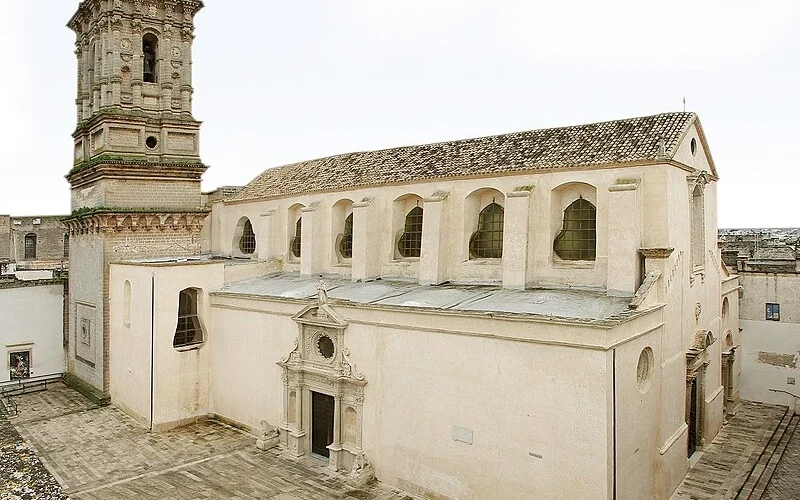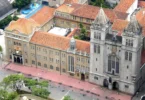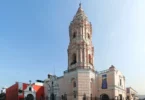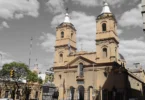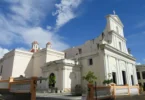Introduction
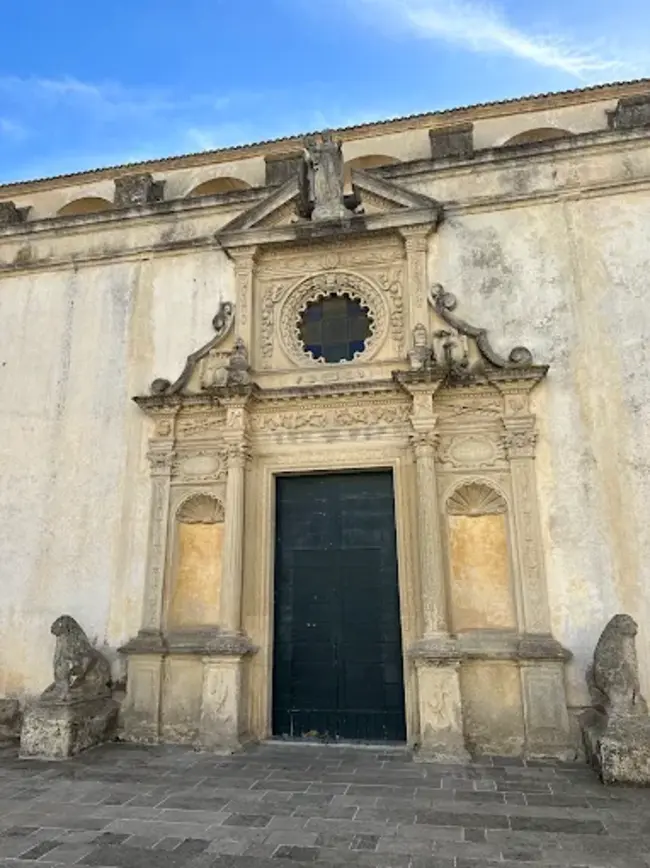
The Basilica of Madonna della Neve is the principal church of Copertino, in the province of Lecce, and serves as the town’s mother church. Its origins date back to the year 1088, when it was founded by the Norman count Goffredo di Conversano, who commissioned its construction and originally dedicated it to the Assumption of the Virgin Mary. With deep historical and religious roots, the church has played a central role in the spiritual and cultural life of the local community for centuries.
In 1255, the church underwent a significant transformation under the direction of Manfred, Prince of Taranto and Count of Copertino. He elevated it to the status of royal basilica and rededicated it to Our Lady of the Snows (Madonna della Neve), a Marian devotion particularly venerated in southern Italy. This title has remained ever since, strengthening the connection between the church and the identity of the people of Copertino. In recognition of its historical, spiritual, and artistic significance, on July 3, 2011, the church was granted the title of minor basilica by the Holy See—an honor given to churches of notable importance in terms of worship and heritage.
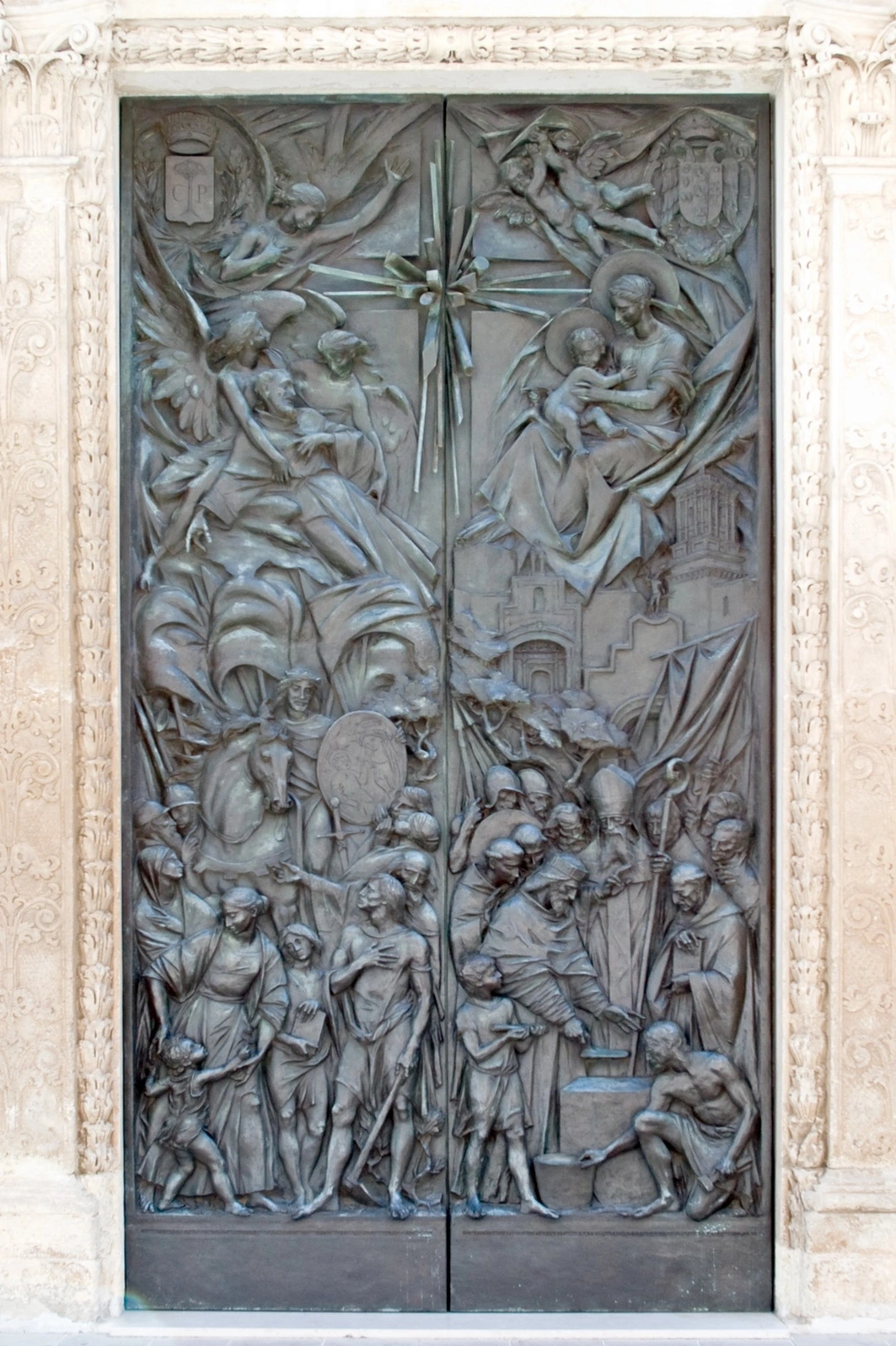
The Basilica of Sancta Maria ad Nives in Copertino holds a remarkable historical and architectural significance, reflecting several key periods in its construction and the rich spiritual heritage of the area. From its medieval origins to its 18th-century restoration, the basilica continues to be a testament to religious devotion and artistic achievement.
Historiographical Notes on the Basilica
The basilica has played a central role in the religious and cultural life of Copertino and beyond. Notably, in 2013-2014, the basilica commemorated the 925th anniversary of its foundation and the 350th anniversary of the blessed passing of Saint Joseph of Copertino. Known as the “Saint of Flights,” Joseph of Copertino is the patron saint of students and exam-takers, as well as the protector of pilots, including those of the Italian Air Force, Argentine Air Force, NATO aeronautical section, and U.S. Air Force pilots. During these anniversaries, the Spanish Post Office issued a commemorative stamp to honor the saint and the basilica. The stamp featured a bronze door design created by the artist Raffaele del Savio and was issued by the Real Casa de la Moneda. The Spanish royal family has a long-standing devotion to Saint Joseph of Copertino, as evidenced by the involvement of King Juan Carlos I in promoting the stamp issuance.
The basilica’s association with Saint Joseph of Copertino is also reflected in its connection to the city of Cupertino, California. The American city, located in the heart of Silicon Valley, shares its name with Copertino and honors the saint. On July 24, 1963, the city of Cupertino, California, officially established a twin-city relationship with Copertino in Italy, further solidifying the bond between these two places and their shared devotion to the saint. Additionally, the city of Copertino is connected to the Belgian royal family, particularly Princess Marguerite de Clermont, who was born in the Copertino Castle and is a descendant of the local nobility. Her ties to the city add a layer of historical and genealogical significance to the basilica.
The basilica has played a central role in the religious and cultural life of Copertino and beyond. Notably, in 2013-2014, the basilica commemorated the 925th anniversary of its foundation and the 350th anniversary of the blessed passing of Saint Joseph of Copertino. Known as the “Saint of Flights,” Joseph of Copertino is the patron saint of students and exam-takers, as well as the protector of pilots, including those of the Italian Air Force, Argentine Air Force, NATO aeronautical section, and U.S. Air Force pilots. During these anniversaries, the Spanish Post Office issued a commemorative stamp to honor the saint and the basilica. The stamp featured a bronze door design created by the artist Raffaele del Savio and was issued by the Real Casa de la Moneda. The Spanish royal family has a long-standing devotion to Saint Joseph of Copertino, as evidenced by the involvement of King Juan Carlos I in promoting the stamp issuance
Architecture of Basilica of Our Lady of the Snows, Copertino, Italy
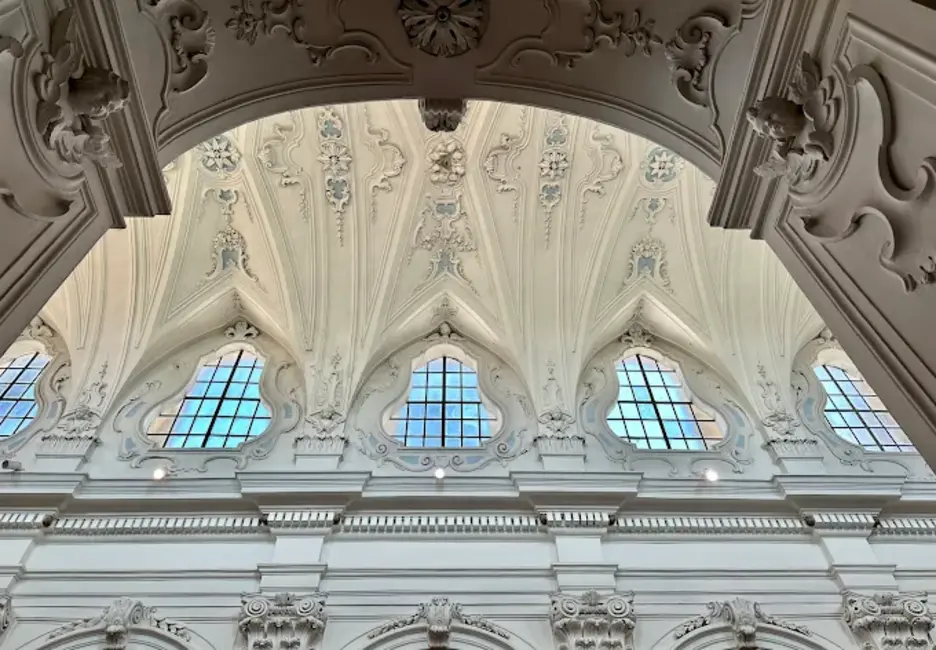
Architectural style: Romanesque architecture, Baroque architecture.
The Main Facade and Architectural Evolution
The facade of the basilica offers a visual narrative of its construction phases. The medieval hanging arches, dating back to the second half of the 13th century, are attributed to the reconstruction efforts of Manfred, who oversaw the temple’s rebuilding. This period is marked by a sense of simplicity and structural fortitude. In 1563, the church underwent significant expansion with the addition of side naves, enhancing its capacity and aesthetic appeal. The next major development occurred in 1580, when a pentagonal apse was constructed, further elevating the structure’s spiritual and architectural grandeur. The basilica was later restored at the beginning of the 18th century, introducing new elements that shaped its current form.
Interior Design and Notable Features
The interior of the Basilica of Sancta Maria ad Nives is a striking example of architectural transformation and artistic elegance. Supported by Romanesque columns, the interior boasts intricately designed capitals that showcase exceptional craftsmanship. Over time, these columns were integrated into quadrangular pillars during the 18th century, significantly altering the original structure. Additionally, the traditional trussed vault was replaced by a hanging ceiling, lavishly decorated with stuccoes that add to the aesthetic richness of the space.
Right Nave and Transept
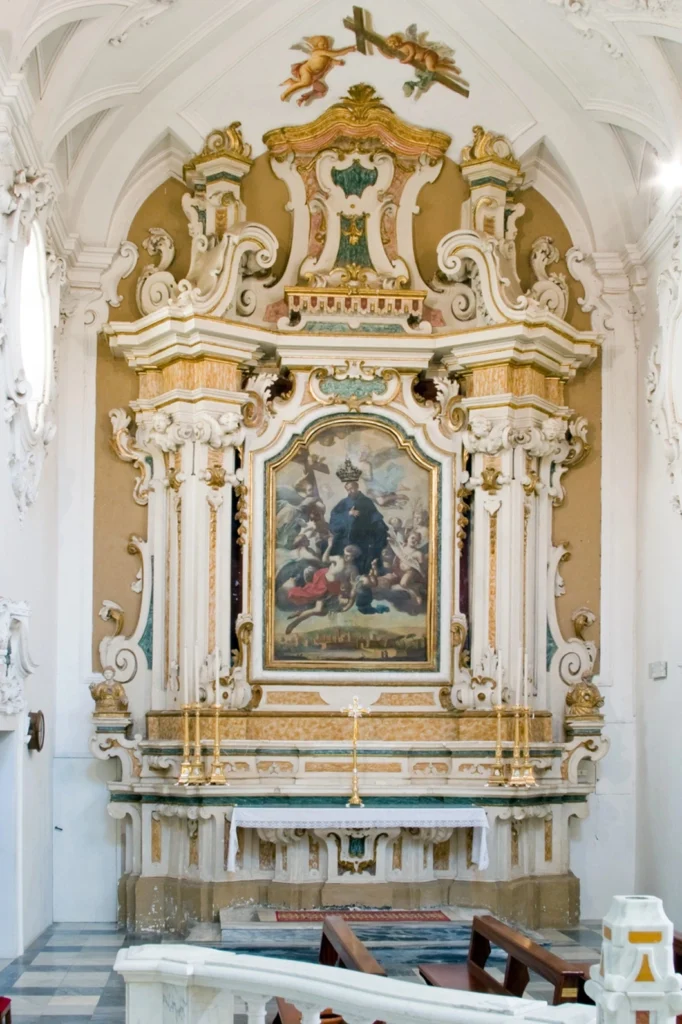
The right nave houses three altars, with the altar dedicated to the Glory of San Giuseppe Desa being particularly prominent. Adjacent to this altar is the Chapel of the Santissimo, which is adorned with remarkable paintings by the artist Gianserio Strafella. In the apse, visitors can admire the wooden stalls crafted in 1793 by Raffaele Monteanni, adding a distinct artistic touch to the sacred space.
Left Transept:
The left transept features the Altar of the Virgin of the Snows, which was constructed in 1630 by Donato Chiarello. This altar encloses a revered 15th-century image of the Madonna, framed in an oval design. Additionally, the Altar of San Sebastiano, adorned with a painting by Fra’ Angelo da Copertino, is situated in the same transept. The left transept is also home to two more altars and a panel depicting the Schiovazione dello Strafella, further enriching the basilica’s spiritual and artistic atmosphere.
Monuments and Historical Significance
At the end of the nave, near the exit, two key historical features of the basilica stand out, each contributing to its rich cultural and religious heritage.
Funerary Monument to Tristano di Chiaromonte:
This monumental tomb serves as a tribute to Tristano di Chiaromonte, an important figure in the region’s aristocracy. The monument emphasizes the basilica’s role not only as a place of worship but also as a significant spiritual center for the local elite. The presence of this tomb within the church underscores the close relationship between the noble families of the area and the ecclesiastical institutions, highlighting the intersection of faith and social status in the region’s history.
Wooden Baptismal Font:
The baptismal font, made of wood, holds historical and religious significance as the site of numerous baptisms, marking it as a sacred space for the initiation of individuals into the Christian faith. One of the most notable events associated with this font was the baptism of Giuseppe Maria Desa on 17 June 1603. Giuseppe Maria Desa, son of Felice and Franceschina Panaca, was baptized by the archpriest Don Delfino Fulino, with Carlo Clarello and Antonia Bizzarra serving as his godparents. This event is a poignant reminder of the basilica’s enduring role in the spiritual lives of local families, marking the start of Giuseppe Maria Desa’s own journey, which would eventually lead to his significant legacy within the religious community.
The Bell Tower: A Monument of Ambition and Design
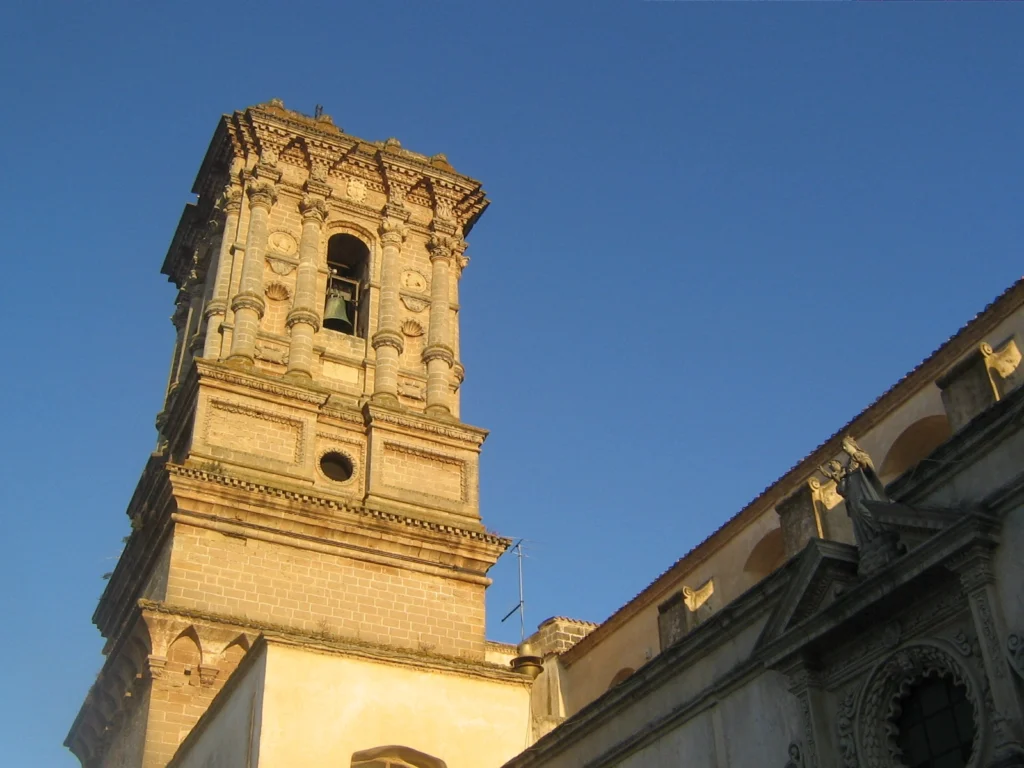
The bell tower of the basilica is an architectural marvel, showcasing the ambitious design intended to enhance the spiritual grandeur of the church. The first documented reference to the tower dates back to 1588, when the tender for its construction was assigned to Giovanni Maria Tarantino, a master from Nardò. Standing at 35 meters tall, the tower has a square base and is divided into two distinct orders. The first order is characterized by simplicity in volume, while the second order exhibits strong sculptural details. The structure is built using massive calcarenite wall partitions, and the tower’s interior is divided into three rooms. The first level is accessible from the transept of the church, with a stairway system connecting the different floors. The tower’s exterior features four columns arranged symmetrically along the facades. These columns rest on pedestals and are adorned with anthropomorphic capitals crafted from Lecce stone. Above these columns, an architrave with friezes depicting floral and symbolic motifs leads up to a composite crowning cornice. The remaining surface areas between the columns feature augustales, supported by brackets, and are counterbalanced by two niches.
Feast Day
Feast Day : 05 August
The feast day of the Basilica of Our Lady of the Snows in Copertino, Italy, is celebrated on August 5th each year. This date commemorates the feast of Our Lady of the Snows (Madonna della Neve), which honors the Virgin Mary, traditionally associated with a miraculous snowfall in Rome during the 4th century, marking the dedication of a church in her honor. The basilica, dedicated to the Virgin Mary under the title “Our Lady of the Snows,” celebrates this day with religious ceremonies and festivities.
Church Mass Timing
Monday to Saturday : 7:00 PM.
Sunday : 8.30 AM, 7.30 PM
Church Opening Time:
Monday to Sunday : 7:30 am – 12:00 pm, 3:00 pm – 6:00 pm
Contact Info
Address:
Basilica of Our Lady of the Snows, Copertino, Italy
Via Gianserio Strafella, 3, 73043 Copertino LE, Italy
Phone : +39 0832 947074
Accommodations
Connectivities
Airway
Basilica of Our Lady of the Snows, Copertino, Italy, to Brindisi Airport (BDS) Contrada Baroncino, distance between 50 min (66.5 km) via SS613.
Railway
Basilica of Our Lady of the Snows, Copertino, Italy, to Zollino Railway Station, distance between 25 min (24.7 km) via SP367.

